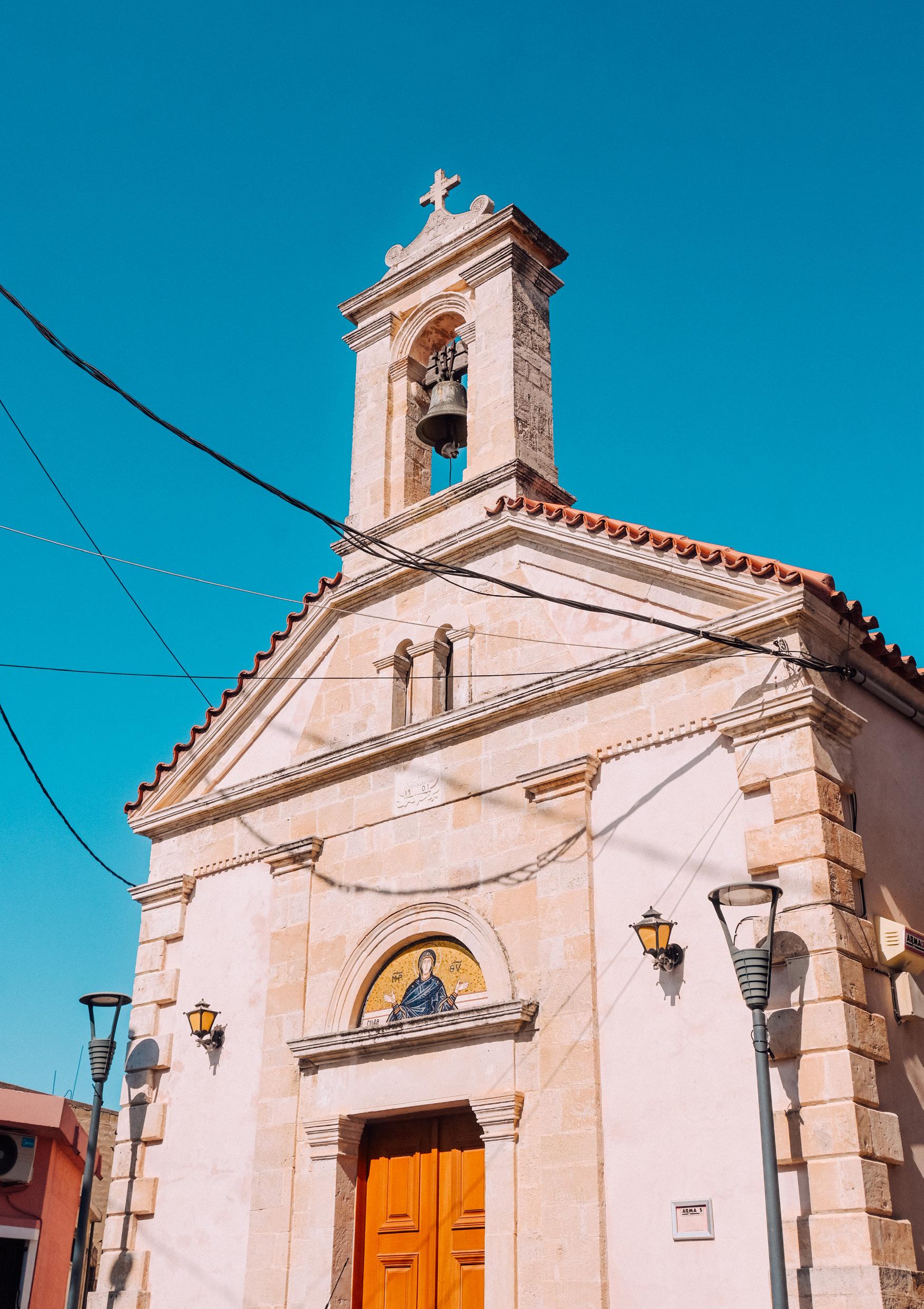Femminile

How Crete, the Island Where Women Were Always Kings, Became the Home of Greece’s Women’s National Team.



How Crete, the Island Where Women Were Always Kings, Became the Home of Greece’s Women’s National Team.

photozine by Akis Katsoudas
Exploring women’s football in Crete
Became the Home of the Greek National Team (16-29) In Crete, It’s Always Summer–Even When It’s Cold Outside (30-38)


In Minoan civilization, women did not stay at home. They moved freely, actively participated in social events, and even hunted. According to scholars, they were the most liberated women of ancient Greece. This is what we know about them today.
It is around 9 a.m. The plane has just landed at Heraklion Airport. The descent was challenging due to the severe weather that has been affecting all of Greece in recent days. In the city, rain is falling, and the clouds are thick and heavy—a rare sight for Crete, the island that always seems to be in summer. Or almost always.
Most of the passengers on the flight are Greek. There are also a few Spanish tourists who don’t seem particularly thrilled with the weather. Together, we board the bus to the city center. First stop for breakfast: the famous Kirkor café in Lions Square, the city’s central plaza. Bougatsa with custard, with cheese, mixed, with sugar and honey—the perfect remedy when you haven’t slept a single minute the night before, as was my case.
Next to me sits another gentleman, devouring not one but two portions of bougatsa. He works for the Greek national broadcaster ERT and has come to the island for the same reason I have—to cover the Greek women’s national team’s first match against Slovenia for the Women’s Nations League qualifiers. We exchange a few words and agree to meet later at the stadium. Despite the cold, a good crowd is expected. After all, Crete has long embraced the team. And how could it be otherwise in an island where, traditionally, women have been the heads of the household?
To trace the roots of Crete’s matriarchal family structure, we need to go back to antiquity—specifically to the Minoan civilization. This advanced society flourished from 3000 BC to 1450 BC before being wiped out by the massive eruption of the Thera volcano and the resulting tsunami that devastated Crete.


From surviving texts, frescoes, and artifacts, we learn that women held a prominent place in Minoan society. They enjoyed freedom of movement and activity, not confined to the home but participating in hunting and athletic events. At the same time, they took great care in their appearance, displaying remarkable elegance.
Minoan women took part in festivals, ceremonies, and competitions as equals to men. In fact, they are still regarded today as some of the most emancipated women of the ancient world. The Heraklion Archaeological Museum holds numerous artifacts that support these claims.
I arrive at the museum a little after 10 a.m. The number of visitors is sparse—nothing like the peak summer season, when the place is swarmed with tourists. It’s just me, a few elderly couples, and a school group on a five-day excursion, making their customary educational visit. Most of the students, however, seem uninterested, eagerly waiting for the tour to end so they can roam the city.
Yet, the Heraklion Archaeological Museum is one of Greece’s most significant museums, home to treasures found nowhere else in the world. My focus is primarily on exhibits related to the role of women in Minoan culture. On the ground floor, two small yet highly significant clay figurines stand out—the Large and Small Snake Goddesses.
These iconic figures of Minoan Crete have sparked much debate regarding their interpretation. Some scholars believe they represent deities— protectors of the household—while others argue that they were priestesses rather than goddesses. Some even link them to Egyptian influences due to Crete’s geographical proximity to North Africa.


On the museum’s first floor, women’s presence becomes even more pronounced. In a hall of frescoes, two stand out in particular: the “Ladies in Blue” and the “Parisian Woman.” Let’s take a closer look at each.
The “Ladies in Blue” fresco is believed to have adorned the antechamber of the throne room. It depicts three female figures standing upright, suggesting a scene from a sacred ceremony. The vivid colors, combined with the meticulous detailing of both the figures and their elaborate garments, make this piece a masterpiece of ancient Greek art. Just a few steps away stands another such masterpiece.
It is the “Parisian Woman.” One might wonder: What does Paris have to do with ancient Knossos? The name was given by archaeologist Arthur Evans, who discovered the fresco in 1903. At the time, the woman’s large eyes, curly hair, bright red lips, and upturned nose embodied the Western ideals of female beauty—hence the name.
This fresco is one of the most famous artworks of the Minoan era. The figure’s expressive eye, painted lips, striking nose, and curly hair exude the vibrancy and naturalism of Minoan art. She wears an ornate ceremonial garment with a sacred knot on her back, symbolizing divine connection. The piece epitomizes the Minoan ideal of harmony and movement, further highlighting how highly women were regarded in this ancient civilization.
And now, several thousand years later, women have once again found a home in this very place. Of course, we’re talking about the Greek women’s national football team, which has found its Ithaca in Crete. And they wouldn’t trade it for anything.



After decades of wandering, the Greek women’s national football team has finally found its Ithaca. We witnessed their match against Slovenia up close and understood why Greek players love playing in Crete—even if it means traveling to the southernmost tip of the country to do so.


The history of the Women’s National Team dates back to 1990. It was just a few years after the first official national championships were held in the country, and the number of women wanting to engage in the sport was rapidly increasing.
The newly formed team played its first match against an unexpected opponent: Taiwan. The game took place on August 29 of the same year at the Kallithea stadium, though the final score remains unknown. A year later, the team played its first official match against Italy, suffering a heavy 6-0 defeat. However, the journey had just begun.
In the following decades, the national team continued to fight but never managed to qualify for the finals of a major tournament. That changed in 2004, though their participation was not secured through qualification but as the host nation of the Olympic Games. They faced the USA, Australia, and Brazil in matches held in Crete and Patras. For years, the team kept moving from city to city, never having a permanent home. That all changed in October 2023, in a historic match against Ukraine. It was the day the national team officially found its home—on the southernmost edge of Greece: Crete.
Those who witnessed that historic victory against Ukraine will never forget it. The stands were packed, the crowd cheered relentlessly, and celebrations erupted at the final whistle. Eleni Markou, who scored the equalizer, will always remember that afternoon in Crete:
“We never expected what happened in those games against Ukraine in Crete. We were used to playing alone, just for ourselves. But the fans gave us incredible motivation to play for them too. Scoring a goal for the national team is something special. And then, hearing your name chanted from the stands—it gives you chills.”






Soula Spyridonidou, who netted the winning goal in the dying minutes, shared a similar sentiment: “The national team is my family, my second home. We’ve been together for years, building a fantastic atmosphere. What happened against Ukraine—we couldn’t believe it. We had never experienced anything like it.”
That victory was crucial in securing Greece’s first-ever qualification for the Euro 2025 playoff stage. Their opponent? Belgium—a team ranked much higher, featuring players competing in Europe’s top leagues. Once again, Crete played its part. Though the Greek team didn’t win, their goalless draw against such a strong side was proof that they were here to stay.
This February, the team reunited in Crete for the Women’s Nations League, this time competing for a place in the World Cup. Their first group-stage opponent was Slovenia, with the match scheduled for the evening of Friday, the 21st. Despite the biting cold, the game drew a solid crowd—mostly locals who had embraced the team and now followed them in every match.
From the opening minutes, Greece showed its competitiveness. Despite Slovenia’s pressure, Beatrix Sarri, who plays for Everton in England, scored with a brilliant chip to make it 1-0. The celebrations were full of passion. It was a promising start, but by halftime, the score was 1-1, leaving everything open.
As time passed, the cold became even harsher. Many photographers paced back and forth to stay warm, while fans huddled under the covered stands to shield themselves from the sea breeze and drizzling rain. An unusual sight for Crete, yet somehow fitting. Eventually, Slovenia found the winning goal, sealing a 2-1 victory. The Greek team fought hard until the end, searching for an equalizer, but none of their chances found the net.


However, no one from the crowd left early. They stayed, cheering and supporting the players. After the final whistle, many children rushed onto the field, eager to take photos with their favorite players.
“Look, that’s Sarri!” a group of three boys excitedly told each other as they watched her climb into the stands to greet her family. In the end, they all got their picture together.
Next up is a crucial match against Ireland in April. And, of course, it will take place in Crete—the place where the women’s national team finally found the home it had been searching for all these years.


August, 2023
A photographic journey through summers, food, the sea, the sun, and the people of the most beautiful island on the planet







